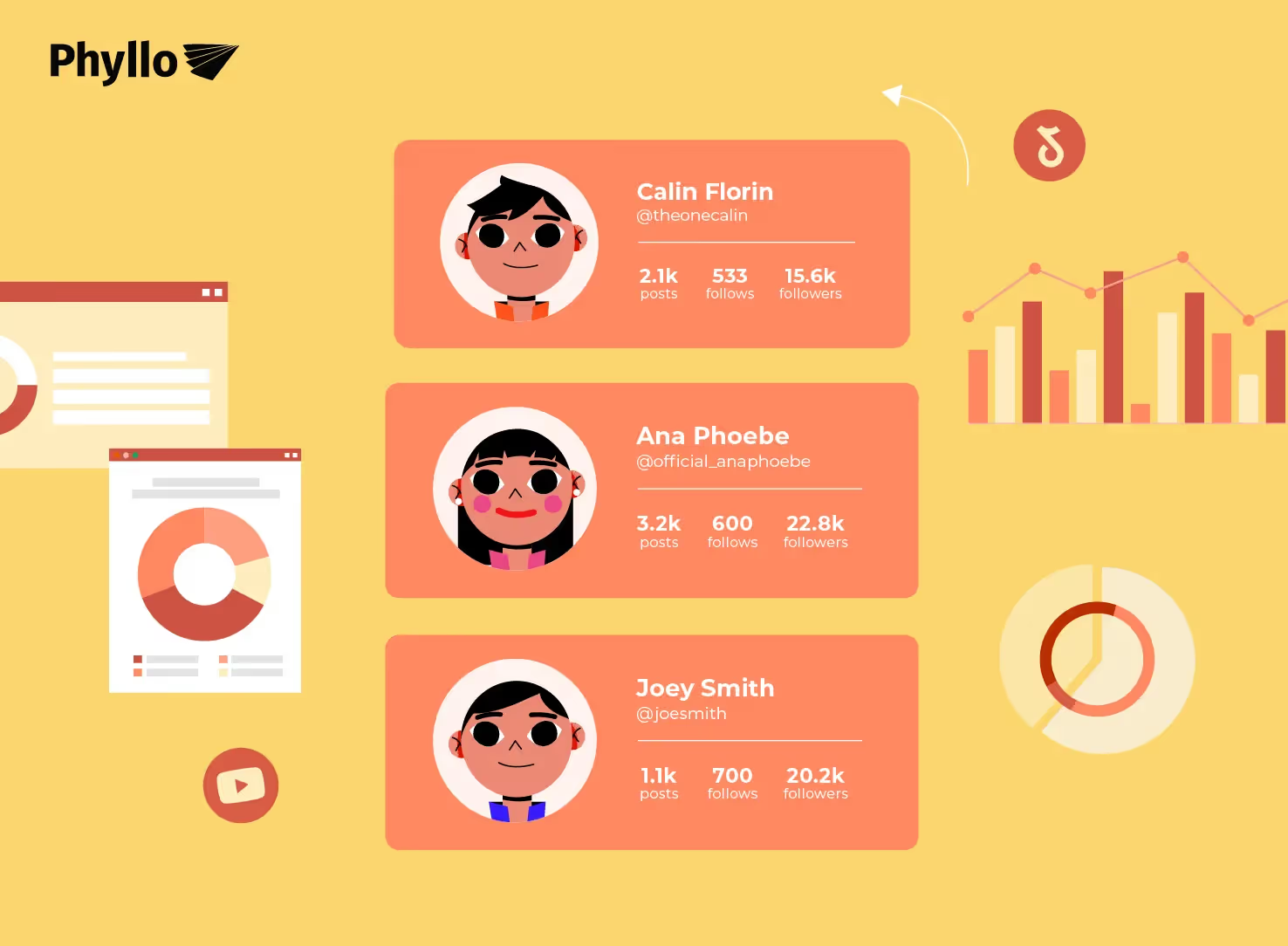With 3.5+ billion installations worldwide, 1+ billion monthly active users, and 167+ million videos watched in an internet minute; TikTok is the new sensation among netizens. A TikTok user, on average, spends 1.5+ hours on this social media platform, and the posts receive the highest engagement rates at 17.96%.
The large user base and unprecedented engagement rates have propelled the rise of TikTok as a must-have channel in marketing strategies. The short-form video-only platform has won over the masses and paved the way for influencers to grow and expand their following. TikTok has quickly emerged as a platform of choice for influencers as it helps them build connections with a large, engaged audience base.
A key factor that sets TikTok apart from other social media platforms is its unique algorithm that surfaces content from various creators, whether it’s a creator just getting started or a seasoned influencer with thousands of followers, allowing new faces to emerge and build a follower base.
TikTok Influencer Marketing: What’s the buzz?
Since its launch in 2016, TikTok has steadily grown by attracting a massive audience base, particularly younger generations. With a vast engaged base and presence of numerous influencers, brands, and marketers quickly noticed the platform's power. Brands began partnering with influencers to increase the reach of their products and services to the masses. Over the years, TikTok has unfolded as one of the most powerful global influencer marketing ecosystems.
In 2022, 42% of US marketers used TikTok for influencer marketing. Reports suggest that by 2025, 54.9% of marketers will leverage TikTok influencers, and 66.4% of influencer marketers will use TikTok.
Marketers see the potential and are working towards creating effective strategies that reach their desired target audience. TikTok’s built-in e-commerce feature allows influencers to link products and services to their content. This helps influencers monetize and gives brands a great platform to take their products to newer markets.

Challenges in finding TikTok influencer analytics
Multiple channels, lack of in-depth information, and limited access to statistics make TikTok influencer marketing cluttered and chaotic. Finding the right influencer is essential but challenging too. Marketers need to scrape through multiple platforms to get the desired metrics like followers, engagement rates, and pricing.
Like other searches, marketers normally rely on hashtags, keywords, location, and audience demographics to shortlist an influencer. Some others directly reach out to them on other social media profiles. Influencer marketing platforms and agencies also help marketers connect with the right influencers based on their criteria and budget.
To ensure the success of any campaign, the fundamentals must be solid. In the TikTok marketing scenario, the critical elements are the influencers themselves. So how do marketers pick the right influencers for a campaign? What are the criteria that matter?
Criteria of finding TikTok influencer
Like any other business decision, influencer marketing, too, must be backed by data. Precise data on both influencers and audience demographics is essential. These are the cornerstones of creating an effective campaign with the most relevant influencers.
Marketers need to analyze specific essential criteria -
- What kind of content will their target audience be interested in?
- Which influencers align best with the content preferred by the target audience?
- What kind of content and posting habits have helped individual influencers garner a following?
- Does the influencers’ content align with the brand’s values?
- Have they collaborated with competitors, and will there be any conflict of interest?
- All key engagement metrics
Marketers need to ensure that the influencers they pick don’t just have a large follower base but they can create content that aligns with the brand. Picking the right influencers goes a long way in garnering the right attention and influencing the interests of the desired audience.
Essential metrics in TikTok influencer analytics
Like most other social media platforms, leveraging metrics is crucial when picking an influencer and tracking the progress of a campaign. TikTok influencer analytics gives a comprehensive view of influencers and enables marketers to make data-driven decisions when choosing an influencer. This analytics deep-dive into key metrics, giving marketers a better understanding of a creator’s account and performance.

The TikTok analytics metrics marketers must track cover all critical areas, including reach, engagement, virality, and conversions.
1. Number of followers
How many people follow an account, and what is the growth trend since the account was created? Getting into the details, marketers can further break it down to understand the gender and geographies of the followers.
2. TikTok engagement rates
- Total engagement
The metric helps gauge the overall performance of an account by giving data on the total number of profile views, videos shared, video views, likes, comments, and shares, over a specified time period. With this, marketers can analyze a creator's growth rate and impact.
- Average engagement rate
The average engagement rate per post is an important metric that helps analyze the impact of a particular video. Engagement rate includes views, likes, comments, and shares on a post, a key metric that helps marketers understand the impact of a campaign and the ROI delivered by an influencer.
- Engagement rate by the view
Breaking it down further, the average engagement per view gives an idea about the performance of a video among followers and people who discover the video on explore. The number of likes, comments, and shares divided by the total number of views helps gauge the impact of a video.
- Engagement rate by followers
Similar to the engagement rate by view, the rate by follower metric gives the number of engagements per follower on a video. This metric analyses the impact of an influencer on their follower base, making it an ideal metric for competitor analysis.

3. Follower growth rate and total follower evolution
A key metric when choosing an influencer is understanding their growth rate. How many followers are they gaining on an hourly and daily basis, what has the growth been like over a 30-day timeframe, and what has the overall follower growth journey been like?
4. Video performance
- Video reach
The total number of views, traffic source breakdown, and audience geography breakdown.
- Video views
How many viewers watched the entire video, the average watch time, and the total watch time on a video?
5. Hashtag growth
Track the performance of a branded hashtag or influencer hashtag created for campaigns. This allows marketers to explore how many views a hashtag has received and how many times a hashtag has been searched.
These metrics help marketers deep-dive into important metrics, compare influencers, understand which influencer can positively impact their brand, and drive the desired engagement.
But here’s the catch - How do marketers access this data, compare, and analyze it?
Phyllo: Empowering marketers with creator- consented TikTok Influencer Analytics
Phyllo provides the perfect balance between authenticated and public data. Our public data offerings provide a frictionless experience, as they do not require you to spend time convincing creators to connect their accounts.
On the other hand, We marketers access authentic, first-party data using our REST APIs. Our data gateway requests creators to grant access to view their data on the Phyllo application. With this, marketers get access to not just creator profiles but otherwise private metrics, and only accessible to the creators. This includes data like audience demographics, views, impressions, reach, and shares.

Our platform API is a reliable source as it is not aggregated data but accurate data received straight from the source itself. Since it is creator-consented, it complies with all data privacy regulations like GDPR and CCPA.
That’s not all. Phyllo provides a universal API for creator data. Beyond just TikTok influencer analytics, marketers can access creator data across a plethora of social media platforms without requiring integrations with multiple APIs. This simplifies the entire process of choosing an influencer, as all decisions are backed by unified data.
With Phyllo, marketers, and creators have access to a single-window view of all metrics, making tracking performance and income data easier. A single API to access normalized data from hundreds of sources.
Want to know more about the platform? Schedule a call now or sign up for a free account and get exploring.









